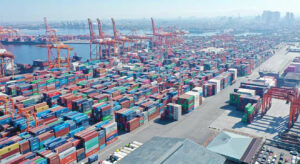PORT CONGESTION is also delaying the unloading of frozen meat, an importers group said, potentially adding another imported commodity to the list of items that cannot be brought to market promptly to mitigate high prices.
“One of the reasons for port congestion is that the containers are not released and unloaded (immediately),” Meat Importers and Traders Association President Emeritus Jesus C. Cham said.
Last week, Agriculture Secretary Francisco P. Tiu Laurel, Jr. cited the need for more ports to fast-track the landing of imported farm goods.
Mr. Cham added that the requirement that shipments bear the seals of the National Meat Inspection Service, and the Bureau of Customs have also caused further delays.
“(Now) they are talking about pre-border inspection, cross-border electronic invoicing, and then you have the cold examination facilities in agriculture (CEFA), these are additional (requirements),” he said.
The CEFAs are intended to ensure that imports are disease-free, and to mitigate the risks from smuggled farm goods.
All imported agri-fishery products are to undergo a 100% examination by the various food regulators overseeing animal industry, plant industry, fisheries and aquatic resources, and meat.
Meat imports rose 9.64% by volume year on year in the first half, led by pork, chicken, and beef, the Bureau of Animal Industry (BAI) reported.
Shipments of imported meat amounted to 647.75 million kilograms during the first six months.
Mr. Laurel has cited the congested ports as delaying rice imports from reaching the market, blunting the intended impact of lower tariffs in containing rice prices.
Mr. Laurel had called for the Philippine Ports Authority to fast track the release of container vans stalled in Manila. About 888 shipping containers holding about 20,000 metric tons of rice have not yet been released.
“The delay in releasing the imported rice has raised concerns over food security, especially as the country faces ongoing inflation pressures,” the Department of Agriculture (DA) said in a statement.
In June, President Ferdinand R. Marcos, Jr. signed Executive Order No. 62 which lowered the tariff on imported rice to 15% from 35% until 2028, citing the need to stabilize rice prices. The order took effect in July.
“It is doubtful whether the 20 million kilos or 20,000 MT in the pier has any impact on prices. It is less than 4% of the 530,000 MT that arrived in the July-August at 15% tariff; 96% of the arrivals are already out in the market,” Federation of Free Farmers National Manager Raul Q. Montemayor said via Viber.
Rice imports have totaled 3.01 million MT as of Sept. 12, according to data from the Bureau of Plant Industry.
Leonardo A. Lanzona, an economics professor at the Ateneo de Manila, said that the delay in landing goods is due partly to importers waiting for more favorable prices.
“Importers seem to have contributed little to the price decreases as their goods are stuck in ports. If the government subsidizes the farmers, instead of lowering tariffs and improving port infrastructure, the rice producers and consumers are protected from these importers who wish to manipulate prices,” he said via Messenger chat.
Mr. Laurel has said that the DA is studying developing 17 ports with private partners that will specialize in handling agricultural shipments.
Mr. Montemayor added that prices could drop with the influx of palay (unmilled rice) during the dry season harvest.
“It doesn’t make sense why they will hold on to these stocks when prices will foreseeably go down when new harvests come in,” Mr. Montemayor added.
“By January, we will have a lot of stocks because of the fresh harvests in September-November, plus imports at 15% (tariff).Prices will go down even without the tariff cut, not because of it,” he said.
The DA has said that the lower tariffs on rice would lead to a P5 to P7 per kilogram drop in imported rice prices. The impact on prices is expected to start showing up in mid-October, but more significant effects could be seen by January. — Adrian H. Halili
